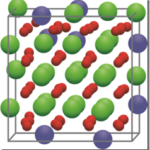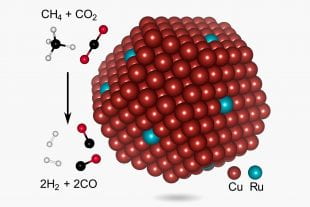(‘Green methane’ from artificial photosynthesis could recycle CO2)
2020/1/10 アメリカ合衆国・ミシガン大学

An electron microscope image shows the semiconductor nanowires. These deliver electrons to metal nanoparticles, which turn carbon dioxide and water into methane. Credit: Baowen Zhou, Mi Group, University of Michigan.
・ ミシガン大学がカナダ・マギル大学およびマクマスター大学との共同研究で、CO2 をメタンに還元する人工光合成の新しいアプローチを開発。
・ 同アプローチでは、銅(Cu)と鉄(Fe)のナノ粒子触媒を載せた窒化ガリウムナノワイヤ(高さ 300nm× 幅約 30nm)で覆ったシリコンウェハーによる光電極デバイスが、太陽光エネルギーや電気で CO2 と水を分解してメタンを生成。CO2 のクリーンな燃料へのリサイクルが 5~10 年以内に実現可能と考える。
・ 今回の研究の主要な進展は、デバイスが比較的多量の電気を利用できることと、この電気をメタン生成に向けられること。電子の半分が水素や CO の副生物の生成でなく、メタン生成反応に使用される。
・ 最大電流密度のうちの僅かな電流で作動するこれまでの人工光合成デバイスとは対照的に、今回、シリコンと Cu-Fe 触媒による光電極デバイスで理論最大値の 80~90%での作動を実現した。
・ CO2 は最も安定した分子の一つであるため、CO2 から炭素を取り出すには大量のエネルギーが必要。同様に、炭素と水素の結合には水を分解する必要があるため、CO2 からメタンへの転換は極めて困難なプロセス。
・ 反応の鍵となる触媒の構成要素の Cu・Fe ナノ粒子を理論計算により特定。Cu と Fe が炭素と酸素原子に取り付くことで、水分子のフラグメントから水素が炭素原子へと移動するための時間を確保する。
・ 同デバイスは太陽光のみで作動するが、電気を利用すればメタン生成量が増加でき、暗室での作動が可能に。実際の利用には、工場の煙突等の CO2 の排出源に繋げる必要がある。また、合成ガスやギ酸を生成するよう改造も可能。ミシガン大学は本研究の触媒に関し複数の特許を保有しており、商業化に向けてパートナーを募集している。
・ 本研究には、Emissions Reduction Alberta、カナダ・自然科学・工学研究機構(NSERC)およびミシガン大学 College of Engineering の Blue Sky Program が資金を提供した。
URL: https://news.umich.edu/green-methane-from-artificial-photosynthesis-could-recycle-co2/
(関連情報)
米国科学アカデミー紀要(PNAS)掲載論文(アブストラクトのみ:全文は有料)
Highly efficient binary copper−iron catalyst for photoelectrochemical carbon dioxide reduction toward methane
URL: https://www.pnas.org/content/early/2020/01/02/1911159117
<NEDO海外技術情報より>
Abstract
A rational design of an electrocatalyst presents a promising avenue for solar fuels synthesis from carbon dioxide (CO2) fixation but is extremely challenging. Herein, we use density functional theory calculations to study an inexpensive binary copper−iron catalyst for photoelectrochemical CO2 reduction toward methane. The calculations of reaction energetics suggest that Cu and Fe in the binary system can work in synergy to significantly deform the linear configuration of CO2 and reduce the high energy barrier by stabilizing the reaction intermediates, thus spontaneously favoring CO2 activation and conversion for methane synthesis. Experimentally, the designed CuFe catalyst exhibits a high current density of −38.3 mA⋅cm−2 using industry-ready silicon photoelectrodes with an impressive methane Faradaic efficiency of up to 51%, leading to a distinct turnover frequency of 2,176 h−1 under air mass 1.5 global (AM 1.5G) one-sun illumination.



